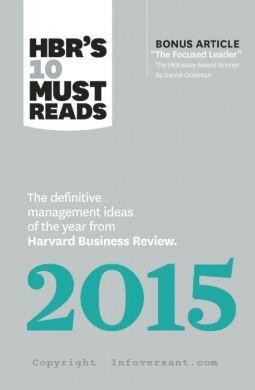The world is changing at a lightning speed. Technology has changed how work is done and it has also changed consumers’ expectation of how things should work. The expectations from organizations are high. To survive in this environment, you need to come up with the next big thing or be nimble enough to adopt and adapt to the next big thing. Central to all this dynamics are, of course, humans. They ideate, they create, and they consume.
 HBR’s 10 Must Reads 2015: The Definitive Management Ideas of the Year from Harvard Business Review
HBR’s 10 Must Reads 2015: The Definitive Management Ideas of the Year from Harvard Business Review
Pages: 208 pages Publisher: Harvard Business Review Press (May 5, 2015) ISBN: 1633690210, 978-163369021
From the ways an organization understands what its consumers want to the policies of how they manage their employees, organizations too need to adjust and re-adjust at a hectic pace. This is a stressful situation and it is easy to jump on too quickly on to the trending bandwagon in fear of losing the bus.
The problem with adopting the trending management principle or approach is that it may not be right for your organization. Was the successful organization trying to solve the same problem that you have? Was the new management approach designed to address the same goal as yours? These and many more questions need to be answered before you adopt the trending approach in hopes that what has worked for others will work for you. Julian Birkinshaw advises the readers to dig deeper and look at the core logic of the new approach. In Beware the Next Big Thing, he discusses the right approach managers should take before they begin adopting a new idea.
Organizational success depends heavily on its leaders. And ability to have a panoramic view of the world around you is central to success. But so is the ability to focus and not get distracted by the myriad distractions. While the ability to stick to one thing can help you to be persistent and stick to the central idea, the ability to soak in information from everything around you can help you make new connections. To connect the dots, you need dots. In The Focused Leader, Goleman discusses various qualities of a successful leader and the cognitive construct that is needed to succeed.
Also Available on Amazon India
Human resource management is more important for success in the information economy compared to as it was in the industrial economy. Organizations have to continuously evolve their policies to attract and retain this scarce resource. Netflix has had tremendous success by implementing policies that went against all the prescribed ways of managing talent. They chose to follow policies based on their philosophy and experience with individuals over what was trending in the HR circles. Patty McCord shares her experiences and things that worked for Netflix in How Netflix Reinvented HR.
Each of the essays in the book focus on one specific function of business. The authors discuss what worked for them in detail and also why they did what they did. For a quick read and to capture the central idea of a topic, each of the chapter provides a snapshot outlining the main idea and the results of their approach.
HBR’s 10 Must Reads 2015 is truly a must read. The essays capture the best and what has worked for organizations from different industries. In HBR’s 10 Must Reads 2015 collection you will get the best of ideas relating to talent management, innovation, marketing, and strategic planning.